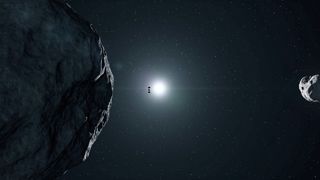
Hera: ESA's Mission to a Damaged Asteroid
- 23rd Sep 2024
- Author: Ed Kellond-Turner
In 2022, NASA's DART spacecraft smashed into the asteroid Dimorphos, altering its orbital period by 32 minutes. Two years later, the European Space Agency are getting ready to launch their own spacecraft to Dimorphos to study the effects of the DART impact, to see if we can gain further knowledge on how to prevent a potentially hazardous asteroid from hitting Earth.
Back to the Scene of the Crime
The Hera mission is Europe's contribution to the Asteroid Impact and Deflection Assessment (AIDA), a collaborative endeavour between ESA and NASA. Due to launch on 7 October 2024 from Cape Canaveral, USA, and is set to arrive in October 2026, Hera will be the first spacecraft to rendezvous with a binary asteroid system. When it gets there, Hera will study both the asteroid Didymos and its moon Dimorphos in great detail, particularly the impact site of DART.
Hera won't be making the journey alone. Along for the ride are two cubesats called Milani and Juventus to compliment the science completed by the main spacecraft. These smaller probes are about the size of a briefcase, and are packed full of equipment to make a complete assessment of the asteroids. Because these cubesats are less important to the overall mission, they can perform the very dangerous task of getting up close and personal with Dimorphos, even attempting to land on the surface.
Hera's Instruments
Hera's main instruments are a pair of cameras called AFC (Asteroid Framing Cameras) that will shed light onto the damage caused by the DART impact in visible light. To compliment these, Hera also carries several other imagers that utilise different wavelengths to provide a complete picture of the asteroid, including TIRI (Thermal Infrared Imager) which was supplied by the Japanese Space Agency.
The two hitchhiking CubeSats have separate scientific goals and instruments. Milani will make spectral surface observations, and Juventus will probe beneath the surface using radar.
The trio of spacecraft will also be in constant communication, and this link can be used to detect and characterise the gravity field of the asteroids.
So We're Safe ... Right?
Binary asteroid systems make up around 15% of all known asteroids, so investigating them to this level of detail is incredibly useful in keeping us safe from killer space rocks. Not only that, but investigating the devastation left by the DART impact will shed light into the properties of near Earth asteroids and how they react to collisions. This could be the key piece of evidence that saves humanity from a world-ending impact.
The issue comes from the time frame of these missions. From conception to impact, the DART mission took seven years to crash into Dimorphos. Hera will take over two years to get to its destination, requiring a gravity assist from a perfectly positioned Mars. But what about if we don't have this kind of time? And what about if the asteroid is difficult to get to? There is clearly still a long way in the task of asteroid deflection, but these two missions are an important step in keeping all of us safe.
Full image references / credits
(Banner Image) Hera at the Didymos system. Credit: ESA
(1) Hera Along With Milani and Juventas at Dimorphos. Credit: ESA, CC BY-SA 3.0 IGO (https://commons.wikimedia.org/wiki/File:Hera_in_orbit.jpg)
(2) The scientific instruments on the Hera spacecraft. Credit: Patrick Michel et al 2022 Planet. Sci. J. 3 160, CC BY 4.0 (https://iopscience.iop.org/article/10.3847/PSJ/ac6f52#psjac6f52f6)
(3) The aftermath of the DART spacecraft impact. Credit: NASA/ITA




